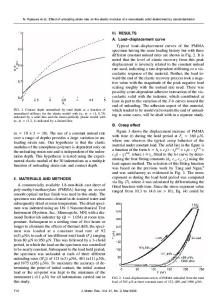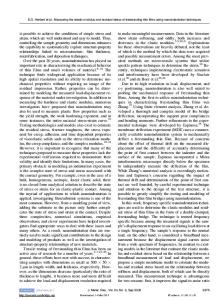On factors affecting the extraction of elastic modulus by nanoindentation of organic polymer films
- PDF / 1,034,382 Bytes
- 6 Pages / 612 x 792 pts (letter) Page_size
- 4 Downloads / 358 Views
R5.2.1
On factors affecting the extraction of elastic modulus by nanoindentation of organic polymer films F.Iacopi1, M.Laknin2, A.Mulloy3, J.M.J.den Toonder4, D.Vanhaeren1, S.H.Brongersma1 1
IMEC, Kapeldreef 75, B-3001 Leuven, Belgium; 2Faculté des Sciences et Techniques, Université d’Aix et Marseille, France 3Materials Science Dept., Trinity College, Dublin, Ireland 4Philips Research Laboratories, Prof. Holstlaan 4, 5656 AA Eindhoven, The Netherlands
ABSTRACT A detailed study of nanoindentation in Continuous Stiffness Mode (CSM) on a family of aromatic thermosetting polymers is carried out to identify the causes for the large variability in the extracted values of the elastic modulus of organic polymer films. It is shown that the variation of parameters determining the dynamics of the force application such as the CSM frequency, the actual strain or load rate, and the duration of the waiting time segments can lead up to 20% difference in the estimated elastic modulus. The reason for this is related to creep, more specifically to viscoelastic behaviour, typical of organic films. On the other hand, pile-up is shown to have a negligible effect on the extraction of the elastic modulus from indentation depths below 50% of the film thickness, even for films with hardness as low as 0.13GPa. It is also concluded that neither pile-up nor creep phenomena can account for the overestimation of the elastic modulus with nanoindentation as compared to the values extracted with the surface acoustic waves technique.
INTRODUCTION The determination of elastic modulus E by nanoindentation on thin and soft supported films is in general a challenging task due to the difficulty in decoupling the elastic response of the film itself from the influence of the stiff substrate [1]. A commonly accepted rule is to extract the modulus from a shallow region, i.e. indent depths of less than 10% of the total film thickness. Moreover, the precision in the determination of the surface position is an additional critical issue for a correct extraction of the elastic modulus from thin films [2]. This all leads to a significant scattering among the E values extracted by nanoindentation on the same thin soft films, depending on the tool used, on measurement conditions and the way the data is analyzed [3]. The nature of organic polymer materials introduces further complexity in the nanoindentation response and hence further variability among elastic modulus values that can be extracted from the same film sample. The additional complexity is given by a large extent of plastic deformation of polymers during indentation with a sharp tip, leading to material pile-up around the tip and thus possible underestimation of the actual film-tip contact area [1, 4]. Moreover, polymers are known to exhibit a time-dependent compliance or creep [5], which can lead to rate effects upon loading and thus again affect the extraction of the elastic modulus [6]. The scope of this work is to achieve a better insight in the critical parameters that have to be taken into accou
Data Loading...











